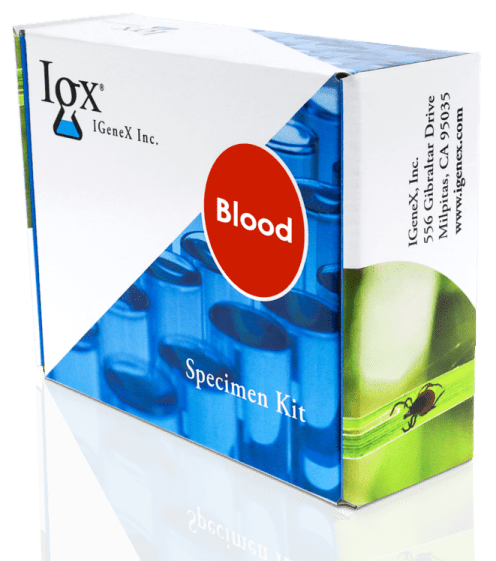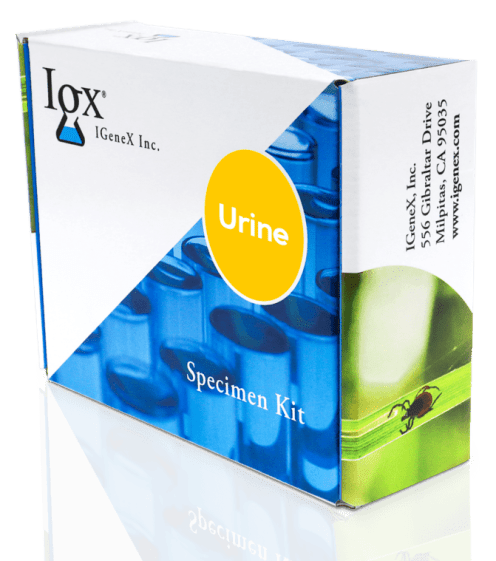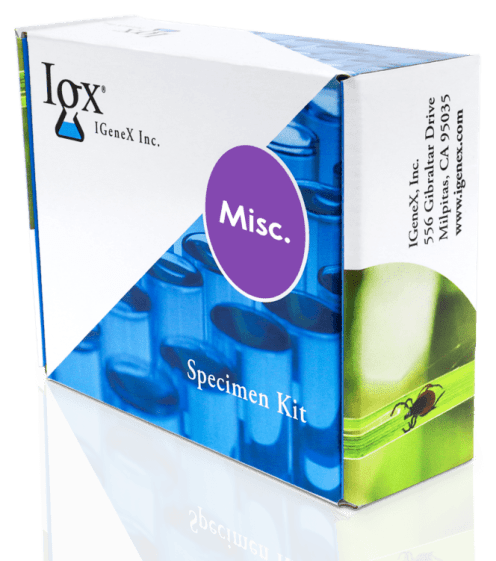Diagnostic Tests for Bartonella
The diagnosis for Bartonella should be considered in patients bitten by a tick or flea or scratched by small animals and are experiencing any of the symptoms typical of Bartonella infections, even mild ones. Patients experiencing these symptoms should be examined by their healthcare professional, who will use clinical symptoms and laboratory tests to determine whether the patient has Bartonellosis or other tick-borne infection.
WHAT TESTS ARE AVAILABLE FOR BARTONELLOSIS?
IGeneX offers IFAs (Indirect Immunofluorescent Assay), ImmunoBlots, PCRs (Polymerase Chain Reaction), Culture Enhanced PCR (cePCR), and FISH (Fluorescent In-Situ Hybridization) tests to confirm the diagnosis of Bartonella. Use the following guide to learn about each test before ordering a test kit.
Bartonella ImmunoBlots IgM and IgG
The Bartonella IgM and IgG ImmunoBlots are designed to detect IgM and IgG antibodies to Bartonella species, including Bartonella henselae, B. quintana, B. elizabethae and B. vinsonii antigens in the serum of patients suspected of having Bartonella infection. The Bartonella ImmunoBlot test results should be used in conjunction with clinical symptoms and other evidence available to the diagnosing practitioner for diagnostic purposes.
Principle
ImmunoBlotting is a form of IgM and IgG testing that uses multiple pure, recombinant proteins sprayed in precise amounts at specific positions on the test strips to dramatically increase accuracy. It has long been considered the gold standard in infectious disease testing for superior sensitivity and specificity. These tests effectively replace traditional tests such as ELISA and the western blot.
Until recently, diagnostic tests for Bartonella have been grossly imprecise and have not been able to detect many of the ever-growing lists of species and strains. The IGeneX ImmunoBlots testing overcomes these obstacles with the ability to detect antibodies to multiple species of Bartonella, including B. henselae, B. quintana, B. elizabethae, and B. vinsonii.
Performance Characteristics
Sensitivity: 15 samples were blood-culture positive for Bartonella and validated with PCR. All 15 samples were verified positive by either ImmunoBlot IgM and/or IgG.
Specificity: Based on a study performed on 34 well-characterized clinical samples, of which 10 of the samples were negative for Bartonella and positive for antibodies to other tick-borne pathogens, the specificity of the Bartonella ImmunoBlot test is 100%.
Advantages
- Far broader and more inclusive of Bartonella species than standard serologies
- More sensitive than Western Blots and/or Immunofluorescence assays (IFA), especially early in the disease
100% specificity, meaning there is little chance of a false positive - Detects the full spectrum of disease: early, active and late-stage disease
- Detects antibodies to Bartonella species and strains from North America, Europe, and Australia
Included Antigens
B. henselae, B. quintana, B. elizabethae and B. vinsonii.
SAMPLE REQUIREMENT: 1.0 ml serum
TEST NUMBER: 374* Bartonella IgM ImmunoBlot 384* Bartonella IgG ImmunoBlot
CPT CODE: 86611 x2, 86317 x3
STAGE OF DISEASE: Any
*Tests/Panels not available for NY Residents
Download datasheet >
View webinar >
View Bartonella ImmunoBlot tests >
Bartonella IgXSpot
This test is recommended to detect very early and/or late infection of Bartonella. For diagnostic purposes, the IgXSpot Bartonella test results should be used in conjunction with clinical symptoms and other evidence available to the diagnosing physician.
Principle
The Bartonella IgXSpot test is an Enzyme-Linked ImmunoSpot (ELISPOT) assay that detects human T cells reactive to specific antigens in vitro. ELISPOT is a widely used method for detecting and monitoring cellular immune responses to specific antigens. The IgXSpot assay allows visualization of the secretory product(s) of individual activated or responding T cells to Bartonella-specific antigens, including Bartonella henselae, B. quintana, B. elizabethae, and B. vinsonii. Each spot that develops in the assay represents a single reactive cell.
Performance Characteristics
Based on a study performed on 48 well-characterized clinical samples, the IgXSpot test displays excellent specificity with the following Bartonella species detected: B. henselae, B. quintana, B. elizabethae, and B. vinsonii.
Advantages
- Detects specific T cell responses soon after Bartonella infection, when antibodies to the organisms are not detectable, or late in the disease when the levels of antibodies are very low.
- When combined with Western Blot tests, provides information on the full spectrum of patient’s immune response to infection and stage of disease.
- Especially useful for seronegative patients.
SAMPLE REQUIREMENT: 6ml heparin tube
TEST NUMBER: 350* – Bartonella IgXSpot
CPT CODE: 86352
STAGE OF DISEASE: Early
*Tests/Panels not available for NY Residents
Sample must be received within 48 hours of collection.
Download Data Sheet >
Results Interpretation >
View Bartonella IgXSpot tests >
Bartonella IFA
The B. henselae Immunofluorescence Assay (IFA) is designed to detect human IgM and IgG antibodies to Bartonella henselae antigens in human serum. For diagnostic purposes, Bartonella henselae IFA test results should be used in conjunction with other information available to the diagnosing physician.
Principle
The Bartonella henselae IFA test is a two-stage sandwich assay, based upon an antigen-antibody-complex formation involving the following steps:
- Binding of anti-henselae-specific antibodies in human serum to fixed henselae on a slide
- Binding of fluorescent-labeled anti-human IgG/IgM antibodies specific to the human anti henselae antibodies bound to fixed henselae on the slide.
- Identifying green fluorescing henselae organisms with a fluorescent microscope
Reference Range
- Bartonella henselae antibody titers IgM <20
- Bartonella henselae antibody titers IgG <40
Clinical Significance
The Bartonella henselae IFA test detects antibodies to B. henselae in human serum. Infections with B. henselae have been associated with Cat Scratch Disease, bacillary angiomatosis, peliosis hepatis, and bacteremia. Bartonella titers rise during the first two-to-four weeks of illness and decline over six-to-12 months. In patients with previously high Bartonella titers, the presence of only an IgG titer of less than 160 may indicate resolving infection. PCR testing is suggested if the IFA is negative, but the clinical symptoms are present.
B. henselae is most often transmitted to humans by cats. Recently, it has been suggested that B. henselae can also be present in the same species of tick that transmits pathogens causing Lyme disease, Babesiosis, and Ehrlichiosis. Therefore, patients with positive titers should also be tested for other tick-borne diseases.
STAGE OF DISEASE: Early, late
Limitations
A negative IFA test result does not exclude the possibility of henselae infection. Results should be interpreted in conjunction with other laboratory and clinical findings.
Bartonella PCR - Whole Blood and CSF
The Bartonella Polymerase Chain Reaction (PCR) test is an assay that detects B. henselae-specific DNA in whole blood and/or cerebrospinal fluid (CSF). The combination of the following three steps imparts a very high specificity and sensitivity to the Bartonella PCR test:
- Hybridization/selection
- Amplification of Bartonella-specific DNA
- Detection of Bartonella-specific amplified DNA fragments
Reference Range
Negative: henselae rDNA was not detected
Clinical Significance
The Bartonella PCR test is an assay that detects B. henselae-specific DNA in whole blood or cerebral spinal fluid. B. henselae ribosomal DNA (rDNA) fragments are hybrid-selected by probes, followed by PCR amplification of selected B. henselae rDNA. PCR products are confirmed by B. henselae-specific probes in a Southern blot assay. The primers and probes used for the selection of rDNA fragments are designed from published small subunit ribosomal RNA sequences..
STAGE OF DISEASE: Any
Limitations
- Bartonella PCR results should be interpreted in conjunction with other laboratory and clinical findings.
- Test results can only help the physician in confirming a clinical diagnosis.
Bartonella FISH
The Bartonella Fluorescent In-Situ Hybridization (FISH) assay is designed for qualitative detection of ribosomal RNA of the Bartonella directly in a blood smear. The test’s highest degree of specificity is provided by nucleic acid probes, which bind to RNA sequences of the pathogen.
Principle
The FISH assay is based on two fundamental principles:
- Hybridization directly on a thin blood smear with a fluorescein-labeled Bartonella-specific probe
- Identification of Bartonella on a blood smear by viewing under a fluorescent microscope
Reference Range
Negative: No green fluorescing rod-shaped bacteria.
Clinical Significance
The Bartonella FISH assay is designed for the qualitative detection of ribosomal RNA of bacteria belonging to the Genus Bartonella. Bartonella is a rod-shaped, gram-negative bacteria. The FISH test provides a significant increase in specificity over standard gram stain for the presence of Bartonella in a whole blood smear. A positive result indicates the presence of bacterium from the Genus Bartonella, including B. berkhoffii, B. henselae, B. quintana, or B. vinsonii. The presence of an organism is a strong indication of disease. Therefore, a positive result can aid in diagnosis during the course of the disease.
STAGE OF DISEASE: Early, late
Limitations
- A negative FISH test result does not exclude the possibility of Bartonella
- Results should be interpreted in conjunction with other laboratory and clinical findings.
Bartonella cePCR - New!
Culture testing is widely considered to be the “gold standard” for diagnosis of Bartonella. For many years, Bartonella cultures were too expensive and tedious to be practical for laboratory use. Until now. After many years of research and development, IGeneX is pleased to introduce cePCR (Culture-Enhanced PCR) for Bartonella.
Download the cePCR datasheet >
Principle
In culturing, a clinical sample from the body (e.g. blood) is incubated in media.
During this incubation period, micro-organisms in the sample grow and multiply. The sample is then tested by PCR to identify the pathogens.
Advantages of Culture-Enhanced PCR
• Provides higher sensitivity than standard PCR testing.
• The only 100% specific method for identification of Bartonella.
• Obtaining cultures before antibiotic use improves the chances of identifying the offending microorganism, which improves patient care.
Stage of Disease
Any stage
Complete Test Directory
THE DIRECTORY
GET STARTED TODAY!
The first step in getting tested with IGeneX is to order a collection kit. Choose between a Blood, Urine, or Miscellaneous kit. Doctors can order unlimited quantities of kits at no charge. Patients are required to deposit $20, which is applied to the testing fees.







